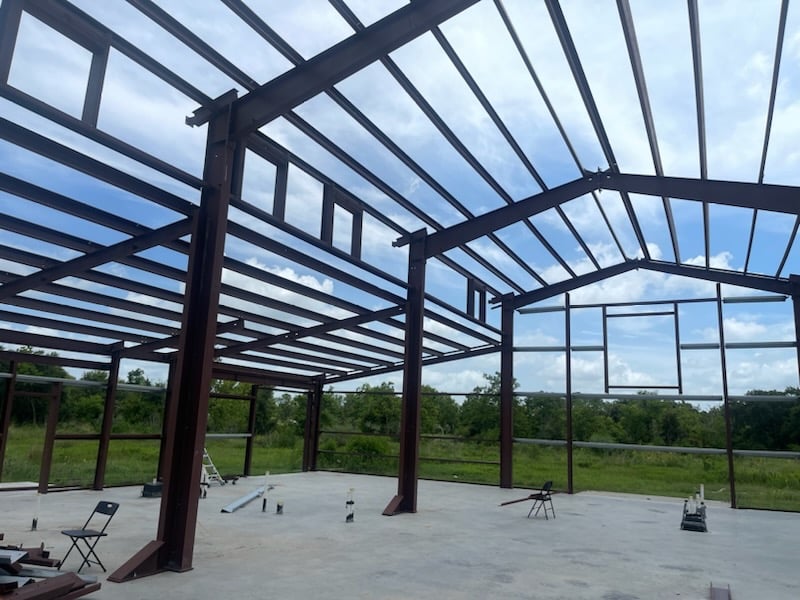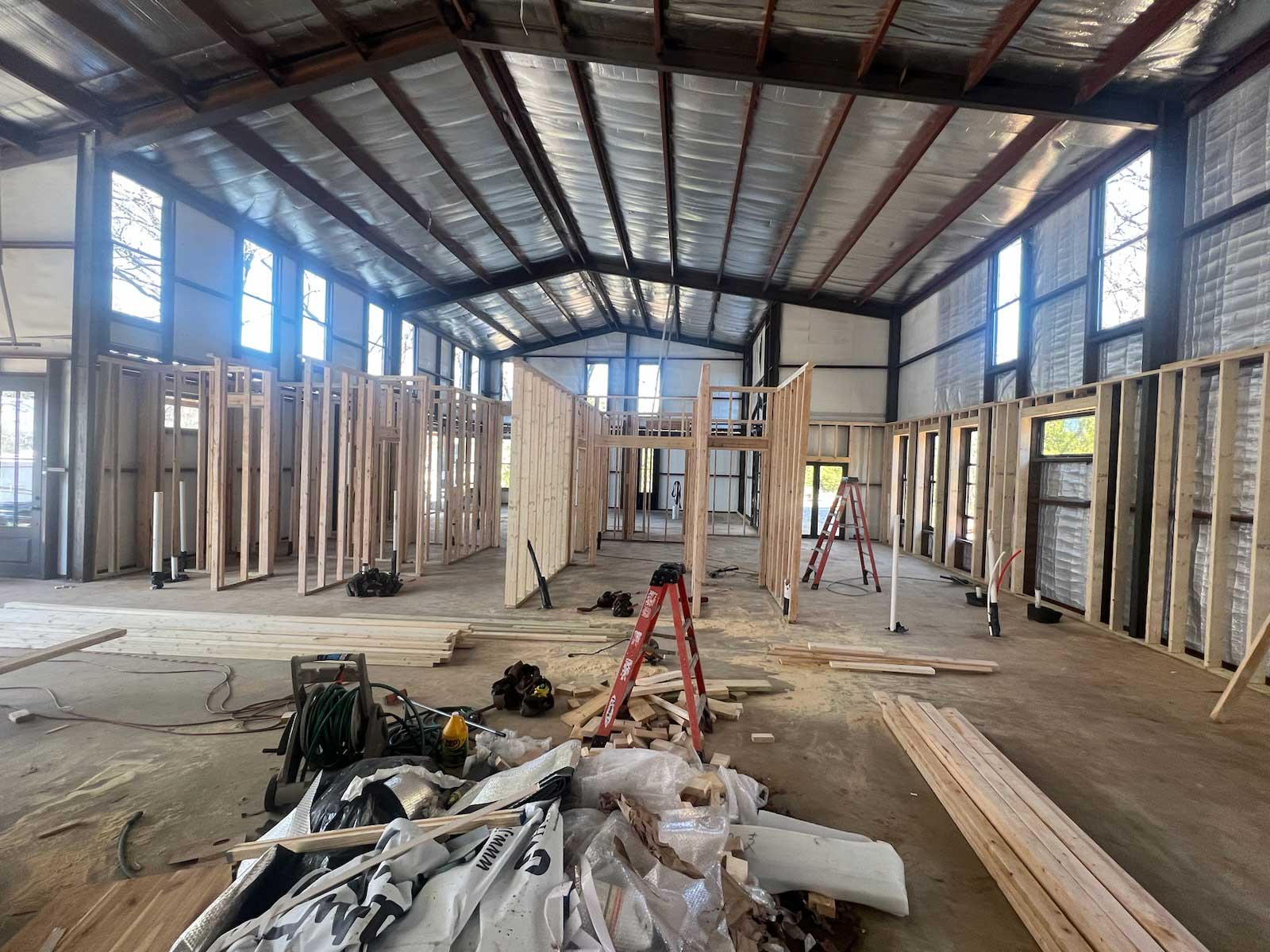
Cold-Formed Steel Home Kits Vs. Red Iron Buildings
When starting the journey to build your dream barndominium, the choice between Cold-Formed Steel Home Kits and Red Iron Buildings is a critical decision point, each with its distinct set of advantages and considerations. This article discusses the basics of what sets these two construction materials apart, dissecting elements such as cost-efficiency, durability, the intricacies of their construction processes, environmental impacts, financial ramifications, and the influence of building codes. Aimed at providing a clear, comparative insight, this article serves as a reference for potential builders, enabling them to navigate the complexities of selecting the best approach to their barndominium that meets their immediate requirements and aligns with long-term expectations and sustainability goals. This article attempts to help the reader find the path toward making a decision that best suits the specific needs of their barndominium.
What are Cold-Formed Steel Home Kits?
Cold-formed Steel Home Kits represent a cutting-edge approach to building construction characterized by their versatility and efficiency. These kits consist of pre-engineered components made from steel shaped at room temperature, enhancing both precision and strength. The design flexibility these kits offer and ease of assembly positions them as a favored option for affordable residential home projects. Note that affordability does not imply they are cheaper in quality; they are just more efficient to build.
Real-World Applications and Case Studies
Case Study 1: Residential Development in Texas
- Project Overview: A community of 50 single-family homes.
- Construction Time: Reduced by 30% compared to traditional wood framing.
- Benefits Realized: Enhanced resistance to fire and termites, leading to lower insurance premiums for homeowners. The project also saw a reduction in construction waste due to the precision of pre-engineered components.
Case Study 2: Affordable Housing Project in New York
- Project Overview: A multi-unit residential building designed to provide affordable housing options.
- Construction Time: Achieved a 25% faster construction timeline, enabling quicker occupancy and return on investment.
- Outcome: The project benefited from Cold Formed Steel’s adaptability to tight urban construction sites and its contribution to achieving energy efficiency standards for affordable housing.
What are Red Iron Buildings?
Red Iron Buildings are synonymous with durability and structural integrity, making it a preferred choice for industrial and commercial projects but red iron is also being used to build homes in the Barndominium sytle.. Constructed from steel coated with a distinctive red-oxide to enhance durability, these buildings boast exceptional resistance to wear and tear. This resilience makes them particularly suited to environments that challenge the longevity of structures. We offer most of our home kits in red iron steel.
One of the features of red iron buildings that we like is their fire resistance. Thanks to the steel’s higher melting points, these buildings offer enhanced safety, potentially leading to lower fire insurance costs. Furthermore, the load-bearing capacity of red iron buildings is unparalleled, supporting heavy loads and catering to the needs of warehouses, manufacturing facilities, and similar projects requiring formidable structural strength. The blend of durability, fire safety, and load-bearing capability renders red iron buildings a reliable option for demanding construction projects.
Real-World Applications and Case Studies
Case Study 1: 3,700 Sq Ft in OK
- Project Overview: This 3,700-square-foot Home Is just north of Texas. It has a large open living area that is only possible with heavy-duty construction techniques.
- Challenges: Changes had to be made to the architectural plans to accommodate the Red Iron.
- Benefits Realized: The home structure was up and closed off in weeks, and work on the internal framing started ahead of schedule. The home is beautiful.
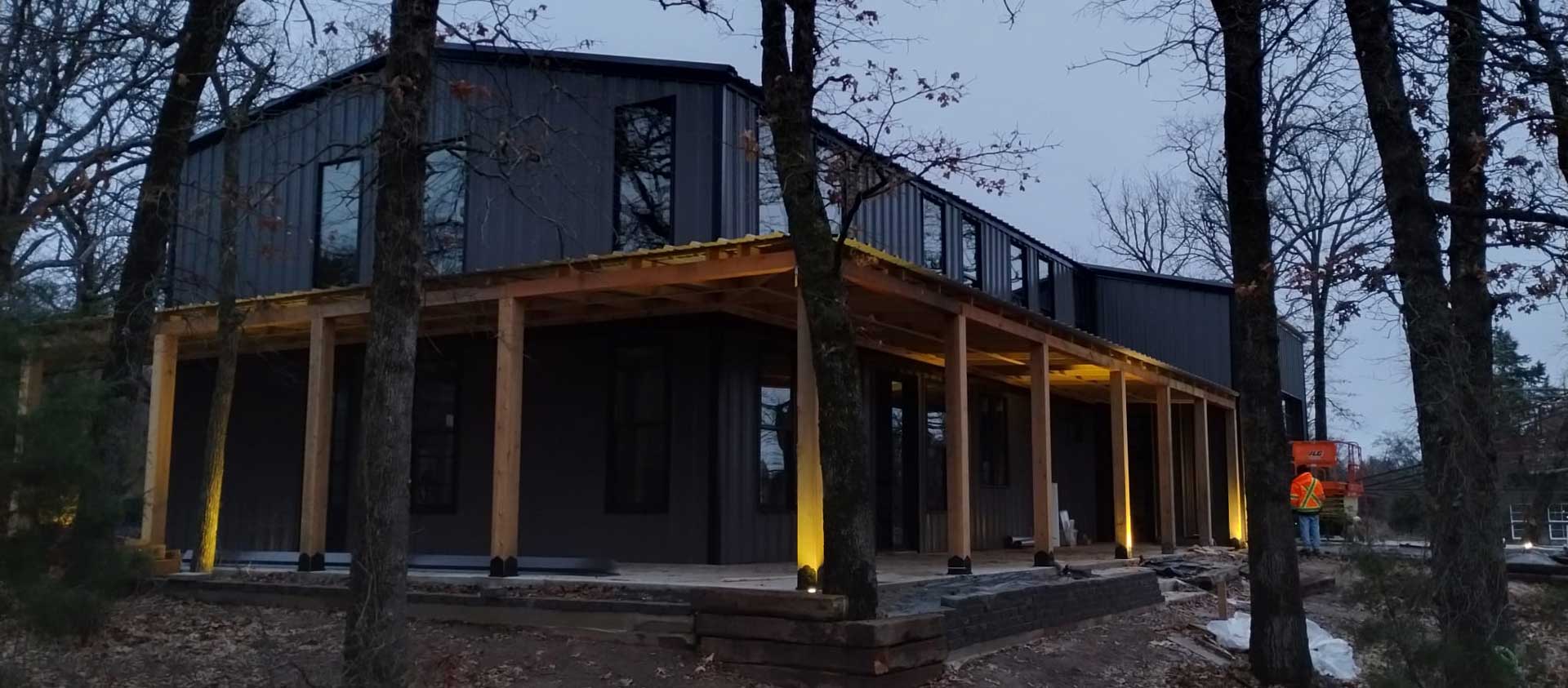
Why choose Cold-Formed Steel Home Kits?
Choosing Cold-Formed Steel Home Kits offers many advantages, chief among them being cost-effectiveness. These kits stand out for their ability to minimize both material costs and labor expenses, facilitated by pre-engineered components and a simplified assembly process. The speed of construction is markedly accelerated, enabling faster project completion compared to traditional construction methods.
Another significant benefit is the flexibility in design. With customizable floor plans and aesthetic versatility, builders and homeowners can tailor their construction projects to meet specific desires and requirements, ensuring the final structure perfectly aligns with their vision. This adaptability makes cold-formed steel home kits a highly versatile option suitable for a wide range of building projects, from residential to commercial.
The amalgamation of these benefits—efficiency, customization, and cost savings—positions cold-formed steel home kits as an appealing choice for those seeking an innovative and practical solution in their construction endeavors.
Comparative Cost Analysis: Cold-Formed Steel Home Kits vs. Traditional Construction Materials
| Cost Factor | Cold-Formed Steel Home Kits | Traditional Construction Materials | Remarks |
|---|---|---|---|
| Material Costs | Lower | Higher | Cold Formed Steel Home Kits utilize pre-engineered components, reducing waste and overall material costs. |
| Labor Expenses | Reduced | Increased | Simplified assembly processes diminish the need for specialized labor, cutting down labor expenses. |
| Construction Speed | Faster | Slower | Pre-planned and pre-engineered elements allow for quick assembly, significantly accelerating the construction timeline. |
| Foundation Requirements | Lighter foundations | Heavier foundations | The lighter weight of Cold-Formed Steel requires less intensive foundation work, contributing to cost savings. |
| Design Flexibility | High | High | Customizable floor plans and aesthetic versatility offer more options without additional costs. |
| Long-term Maintenance Costs | Lower | Higher | Resistance to common issues like pests and moisture reduces long-term upkeep expenses. |
| Energy Efficiency Potential | Higher | Higher | Enhanced insulation options lead to considerable energy savings over the building’s lifespan. |
Why choose Red Iron Buildings?
Opting for Red Iron Buildings is a strategic choice for those prioritizing durability and longevity in their construction projects, especially in industrial and commercial settings. These buildings are distinguished by their resistance to wear and tear, making them a robust option for demanding environments.
A key advantage of red iron buildings is their fire resistance. This feature not only enhances the safety of the structure but also may lead to lower insurance costs due to the material’s higher melting points. This aspect of red iron buildings offers peace of mind in terms of safety and financial savings.
Moreover, the load-bearing capacity of red iron buildings is exceptional, enabling them to support heavy loads effortlessly. This capability is particularly beneficial for structures like warehouses and manufacturing facilities, where supporting substantial weight is a fundamental requirement. The blend of durability, fire safety, and load-bearing strength makes red iron buildings a reliable and wise investment for projects where these qualities are paramount.
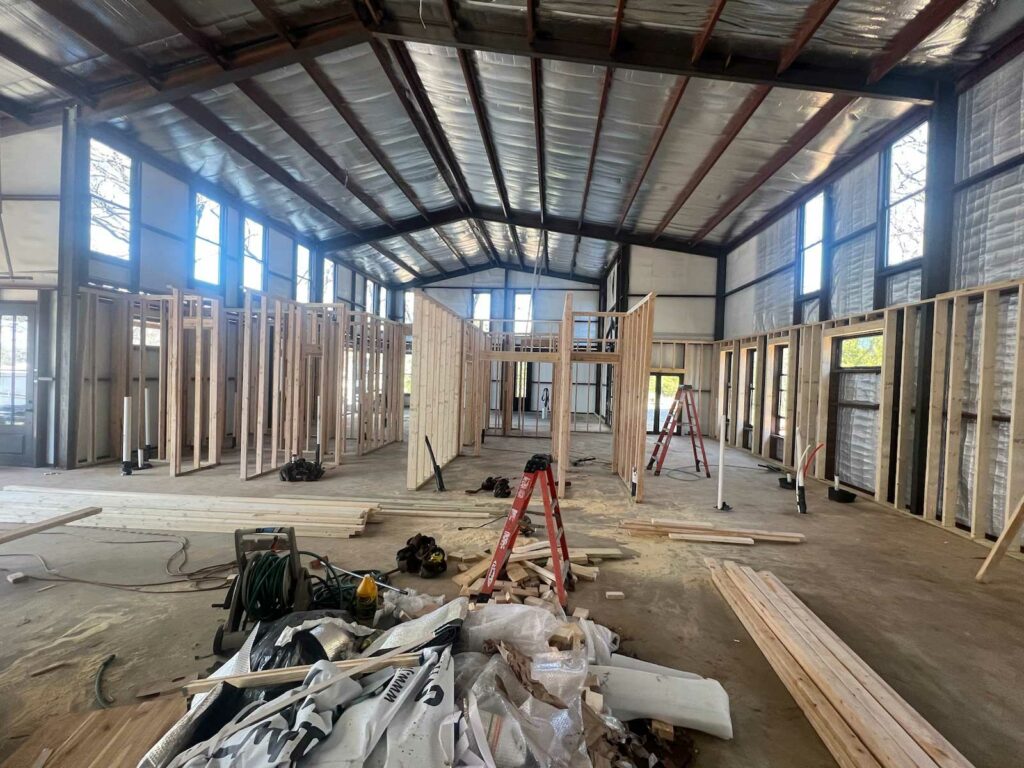
Longevity and Maintenance Savings: Red Iron Buildings in Harsh Climates and Industrial Applications
| Feature | Benefit | Example/Case Study |
|---|---|---|
| Durability | Red Iron Buildings withstand severe weather, including hurricanes and heavy snow. | In coastal areas prone to hurricanes, Red Iron Buildings have remained intact while other structures suffered damage. |
| Resistance to Wear and Tear | High resistance to daily operational stresses ensures longevity. | Manufacturing facilities with heavy machinery report minimal structural wear over decades of use. |
| Longevity in Harsh Climates | Designed to endure extreme conditions without significant degradation. | In northern regions with heavy snowfall, Red Iron Buildings have shown superior roof load-bearing capacity, preventing collapses. |
| Fire Resistance | Enhanced safety and potential for lower insurance premiums. | A warehouse fire in a Red Iron Building was contained without structural failure, leading to reduced losses and insurance claims. |
| Higher Melting Points | Steel’s higher melting points contribute to robust fire resistance. | During a fire incident in an industrial complex, Red Iron Buildings resisted fire spread, protecting valuable assets. |
| Reduced Fire Insurance Premiums | Lower risk of fire damage can lead to insurance savings. | Businesses housed in Red Iron Buildings have reported up to 20% savings on fire insurance premiums. |
| Load-bearing Capacity | Supports heavy loads, ideal for warehouses and manufacturing facilities. | A Red Iron Building warehouse supports heavy inventory stacks and crane operations without structural stress. |
| Support Heavy Loads | Essential for industrial applications with substantial equipment. | In heavy manufacturing plants, Red Iron Buildings accommodate large machinery, enhancing operational efficiency. |
| Suitable for Industrial Applications | Dependable solution for industries prioritizing efficiency and safety. | A chemical processing plant utilizes Red Iron Buildings for its durability and resistance to corrosive materials. |
How do Cold-Formed Steel Home Kits and Red Iron Buildings differ in construction?
The distinction in construction between Cold-Formed Steel Home Kits and Red Iron Buildings lies primarily in their foundation requirements and assembly processes. Cold-formed steel necessitates lighter foundations, offering greater flexibility for a variety of ground conditions and contributing to a faster construction timeline due to less intensive foundation work.
Conversely, Red Iron Buildings demand heavier foundations to support the weight of the material, making them a robust choice for projects where durability and load-bearing capacity are critical, such as in industrial settings. The assembly of these buildings typically requires welding, a method that calls for skilled labor and extends the construction period, unlike the bolt-together assembly of Cold-Formed Steel Kits, which can be accomplished more swiftly and with less specialized labor.
These core differences in construction approach significantly impact the project’s duration, labor requirements, and overall expenses, highlighting the importance of choosing the right material based on the specific needs and goals of a construction project.
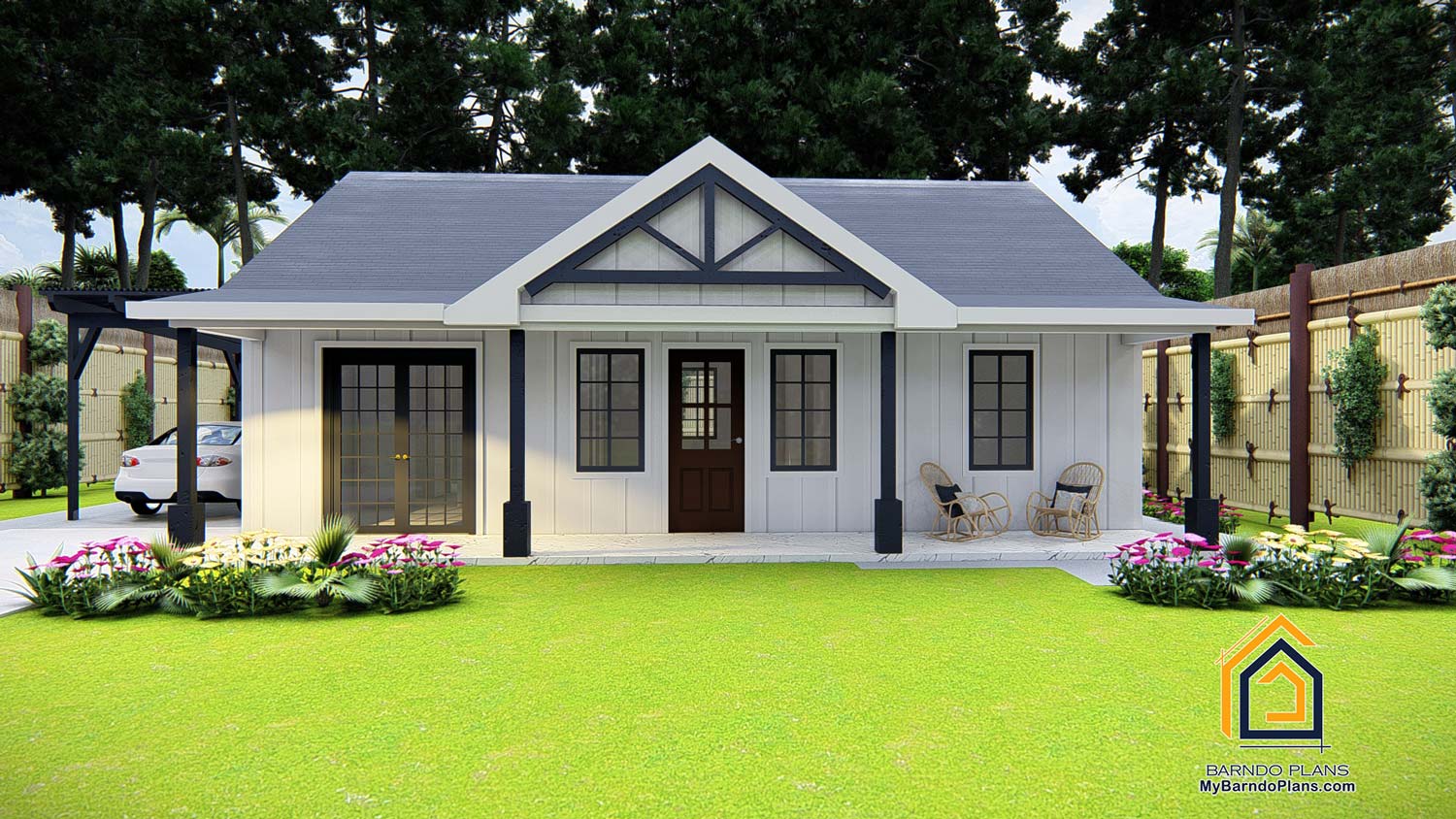
Detailed Comparison: Foundation Requirements and Assembly Processes
| Aspect | Cold-Formed Steel Home Kits | Red Iron Buildings | Comparison |
|---|---|---|---|
| Foundation Requirements | Lighter foundations due to the material’s lighter weight. | Heavier foundations are required to support the substantial weight of the material. | Cold-formed steel offers more flexibility and potential cost savings in foundation work due to lighter weight requirements. |
| Assembly Process | Bolt-together assembly facilitates a faster build with fewer specialized labor requirements. | Welding required, necessitating skilled laborers and extending the construction timeframe. | Cold-formed steel Home Kits can be assembled more quickly and with less specialized labor, reducing both time and labor costs. |
| Construction Speed | Faster construction timeline due to simplified assembly process. | Longer construction period due to welding and heavier foundation work. | Cold-Formed Steel Home Kits enable faster project completion, offering a time-saving advantage over Red Iron Buildings. |
| Labor Cost Comparison | Reduced labor costs due to fewer specialized skills required for assembly. | Higher labor costs due to the need for skilled welders and additional labor for foundation work. | The simplified assembly process of Cold-Formed Steel Home Kits results in significant labor cost savings compared to the more labor-intensive Red Iron Buildings. |
| Material Handling | Components are lighter and easier to handle, reducing the need for heavy lifting equipment. | Heavier components require cranes or other lifting equipment during assembly. | Cold-Formed Steel Home Kits are more manageable on-site, potentially reducing equipment rental costs. |
| Flexibility in Construction | Greater adaptability to various ground conditions due to lighter foundation requirements. | Less flexibility in site selection and preparation due to heavier foundation needs. | Cold Formed Steel Home Kits, once engineered are set-in-stone unless they go back to engineering. Red Irong offers more versatility in construction changes on site because the kits are only the shell. |
| Time to Project Completion | Generally quicker from start to finish due to efficiencies in assembly and foundation work. | Longer project timelines are influenced by the complexity of welding and foundation construction. | Cold-Formed Steel Home Kits can lead to a swifter return on investment and earlier occupancy due to reduced construction timelines. |
| Case Study Example | A residential project utilizing Cold-Formed Steel was completed in 3 months. | A large barndominium with Red Iron will be ready to begin framing in 3-6 weeks. | The Cold-Formed Steel residential project was completed 33% faster than the Red Iron home, illustrating the time-saving benefits of Cold-Formed Steel. |
What are the environmental considerations?
In choosing between Cold Formed Steel Home Kits and Red Iron Buildings, environmental considerations emerge as a pivotal factor. Both options, being steel-based, inherently benefit from sustainability through their capacity for recyclability, markedly reducing their ecological impact. However, Cold-Formed Steel distinguishes itself by having a lower environmental impact during both the production and construction phases, thanks to its lighter weight and the efficiency of its manufacturing process.
Moreover, the energy efficiency of the constructed building is a critical environmental consideration. Cold Formed Steel Home Kits excel in this area by offering enhanced insulation options, which boost their energy-saving potential over the building’s lifetime. In contrast, despite their structural robustness, Red Iron Buildings may not naturally offer the same level of thermal performance. Nevertheless, with the right design choices and additional insulation, their energy efficiency can be improved.
Addressing these environmental factors is crucial. They impact not only the construction project’s immediate environmental footprint but also the long-term sustainability and energy consumption of the building.
Sustainability of materials
The sustainability of materials plays a vital role in the environmental impact of construction projects. Both Cold-Formed Steel and Red Iron Buildings leverage the sustainability of steel, a material lauded for its ability to be efficiently recycled and reused, fostering more eco-friendly construction practices.
Recyclability of steel
The recyclability of steel is a significant environmental boon, dramatically diminishing the ecological footprint of building projects. This feature ensures that constructions using either Cold Formed Steel or Red Iron contribute positively to sustainable building initiatives.
- Statistical Data: According to the Steel Recycling Institute, steel has a recycling rate of more than 60% in the United States, making it one of the most recycled materials in the country.
Lower environmental impact of Cold Formed Steel
Cold Formed Steel distinguishes itself with a lower environmental impact, attributable to the production process’s efficiency and the material’s lighter weight. These factors lead to reduced emissions during transportation and construction, highlighting Cold Formed Steel’s advantage in sustainable building.
- Case Study: A study published in the Journal of Constructional Steel Research highlighted that buildings constructed with cold-formed steel resulted in a 20% reduction in greenhouse gas emissions compared to traditional construction methods.
Energy efficiency
Energy efficiency stands as a paramount environmental consideration. Buildings erected with Cold Formed Steel and Red Iron are particularly adept at achieving high energy efficiency due to their compatibility with advanced insulation options.
Insulation Options for Cold-Formed Steel
These insulation options enable structures made from Cold Formed Steel to maintain comfortable indoor temperatures with less energy consumption, thereby bolstering the material’s sustainability credentials.
- Energy Savings Potential: Research by the American Iron and Steel Institute indicates that buildings constructed with cold-formed steel framing and proper insulation can achieve up to 40% energy savings on heating and cooling costs over traditional stick-built homes.
Thermal Performance of Red Iron Buildings
Though Red Iron Buildings are known for their structural strength, their thermal performance can be optimized through careful insulation and design choices. This adaptability allows for enhanced energy efficiency, making Red Iron Buildings a competitive option for environmentally conscious construction endeavors.
- Improvement with Insulation: A case study involving a red iron building retrofitted with advanced insulation materials reported a 30% improvement in thermal efficiency, leading to significant reductions in energy consumption for climate control.
What are the financial implications?
When comparing the construction of Cold-Formed Steel Home Kits versus Red Iron Buildings, it’s essential to consider the financial implications across several dimensions: initial costs, the impact of construction speed on costs, and long-term savings. The upfront cost comparison often shows that Cold-Formed Steel Home Kits can be more budget-friendly, attributed to reduced labor costs and simplified assembly processes. These factors not only make the initial investment more manageable but also speed up the construction timeline, further economizing the overall project expenditure.
Moreover, the long-term savings offered by these construction methods are significant. Buildings crafted from Cold Formed Steel stand out for their energy savings potential, thanks to enhanced insulation options that promise reduced utility expenses over the building’s life. On the other hand, while Red Iron Buildings might present higher initial costs, particularly due to the labor-intensive welding and assembly required, their durability and minimal maintenance costs over time can lead to substantial financial benefits in the long haul.
Grasping these financial nuances is critical for making an informed choice that not only respects immediate budgetary limits but also optimizes long-term financial outcomes, ensuring the selected construction approach delivers enduring value throughout the building’s lifespan.
Financial Comparison: Cold-Formed Steel Home Kits vs. Red Iron Buildings
| Financial Aspect | Cold-Formed Steel Home Kits | Red Iron Buildings | Notes |
|---|---|---|---|
| Initial Construction Costs | $150,000 – $200,000 | $180,000 – $230,000 | Costs include materials, labor, and foundation work for a standard 2,000 sq. ft. building. |
| Time to Completion | 4-6 months | 6-9 months | Faster construction for Cold-Formed Steel reduces labor costs and allows for earlier occupancy. |
| Maintenance Costs (Yearly) | $500 – $1,000 | $1,000 – $2,000 | Cold-Formed Steel typically requires less maintenance due to resistance to corrosion and pests. |
| Energy Efficiency | High | Moderate | Cold-Formed Steel offers better insulation options, leading to lower heating and cooling costs. |
| Long-term Savings (20 years) | $20,000 – $40,000 | $10,000 – $20,000 | Savings include reduced maintenance and energy costs. |
| Resale Value | High | Moderate to High | Cold-Formed Steel’s durability and energy efficiency can enhance resale value. |
| Insurance Costs | Lower | Higher | Due to better fire resistance and durability, Cold-Formed Steel may have lower insurance premiums. |
How do building codes affect the choice?
Building codes play a pivotal role in determining the suitability of Cold-Formed Steel Home Kits versus Red Iron Buildings, as they set forth critical standards on structural integrity, safety, and energy efficiency. The variability of these codes by region means the choice between these materials can greatly depend on local regulations. For example, areas with a high likelihood of seismic events may impose rigorous seismic performance standards, potentially favoring the adaptability and resilience of Cold-Formed Steel. Conversely, locales that experience high wind speeds might require buildings to meet elevated wind resistance capabilities, making the robustness and load-bearing strength of Red Iron Buildings more appealing.
Understanding the nuances of these building codes is essential for making an informed decision that not only complies with legal requirements but also ensures the building’s structural and operational efficiency is optimized for its specific environmental conditions.
Local regulations
Local regulations play a crucial role in shaping the construction environment, mandating specific safety, durability, and efficiency standards. These regulations are designed to ensure that buildings are well-suited to their communities’ unique needs and challenges.
Variability by region
The variability by region in building codes means that construction practices and materials that are ideal in one area may not be suitable in another. This regional diversity necessitates a comprehensive understanding of local codes to make informed decisions regarding construction materials and architectural designs.
Impact on design choices
This regional variability significantly impacts design choices, guiding architects and builders towards materials like Cold Formed Steel or Red Iron that comply with local requirements and suit the environmental conditions of the area.
Structural requirements
Structural requirements are at the heart of building codes, establishing critical benchmarks for safety and resilience. These standards are vital for ensuring that buildings can endure the specific environmental stresses prevalent in their location, from heavy snowfall to intense winds.
Seismic performance
In areas prone to seismic activity, seismic performance becomes a key factor. Building codes in these regions demand structures that possess both the flexibility and strength necessary to withstand earthquakes, directly influencing the choice of construction materials and techniques employed.
Wind resistance capabilities
Likewise, wind resistance capabilities are essential in regions vulnerable to hurricanes or high winds. Local codes in such areas dictate that buildings must be capable of resisting these forces, guiding the selection towards materials that provide the requisite strength and durability to meet these challenges.
At My Barndo Plans, we think that any single-story home without large open spans should be constructed in Cold-Formed Steel. These buildings don’t need the extra weight and strength of I-Beam construction and the speed of erecting the building is much quicker. If you are building a large Barndominium with massive open spans of space, Red Iron or Post Frame Construction are better options for your barndo or home at this time.

